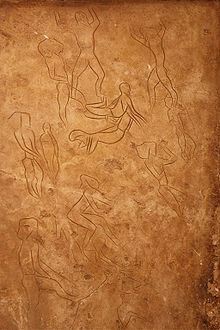|
Mondello
Mondello (Sicilian: Munneḍḍu) is a seaside district of the city of Palermo in the autonomous region of Sicily, in Southern Italy. It lies on a sandy bay delimited by two hills called Mount Gallo (or Rooster) and Mount Pellegrino (or Pilgrim), in the northernmost area of the city. Archaeological evidence of settlement in the area dates back to the Upper Paleolithic and Chalcolithic[1]. In medieval times a small village arose on the northern edge of the bay. The community prospered economically due to the abundant profits from fishing and agriculture. In the 15th century a tuna fishery was built, which quickly became the most successful business in the village. In that period the military defense of the place became necessary due to the frequent attacks by Barbary corsairs[2]. In the late 18th century, much of the area was annexed to La Favorita Royal Estate, the private estate of King Ferdinand I of the Two Sicilies. In the early 20th century, Mondello became a luxury seaside resort for the aristocracy and the bourgeoisie. In 1909, the Municipality of Palermo reached an agreement with an Italian-Belgian company for the construction of a new district in the area aimed to the wealthier social classes. The new neighborhood was planned according to the canons of the garden city movement and its construction involved the leading architects of the Palermo modernist school, such as Ernesto Basile and his students[3]. A number of Liberty style villas on the seafront promenade have made it one of the gems of Art Nouveau in Europe[4][5]. Later, Mondello grew into a tourist destination and it is currently considered the main seaside resort of Palermo. ToponymyHistorical evidences show that Mondello's name has been in regular use since at least the 16th century, but its etymological origins remain uncertain. According to the version most accredited by researchers, it appears to be an Italian alteration of the Arabic Al Mondellu, which means "The Swamp", because during the Islamic domination of Sicily, between the 10th and 11th centuries, the area was known for the presence of a marsh on the south-eastern side of the bay. HistoryAncient history The area has been settled since the Upper Paleolithic. Prehistoric tribes used the caves in the mountains surrounding Mondello as dwellings and, in some cases, as places of shamanic ritual[6]. During the Chalcolithic, with the changing climatic and social conditions, several villages with annexed necropolises arose in the vicinity of the current inhabited centre. Around the 7th century BC the bay was regularly visited by Phoenician sailors, as demonstrated by the discovery of a sanctuary dedicated to the ancient goddess Isis in a cave on Mount Gallo known as Cave Regina (or Cave Queen), which was used as a place of worship since the prehistoric age[7][8]. The Greek historian Polybius mentioned that the Carthaginian general Hamilcar Barca used Mondello as a landing point for his fleet during the First Punic War, in the 3rd century BC[9]. During the years of Roman domination, the intense deforestation of Mount Pellegrino caused the formation of a swamp in a section of the area known as Valdesi, on the southern side[10]. Medieval history In medieval times a small village arose on the northern edge of the bay. The community prospered economically due to the abundant profits from fishing and agriculture. In the 15th century a tuna fishery was built, which quickly became the most successful business in the village. Modern historyUntil the beginning of the 20th century, Mondello was an unhealthy marsh enclosed by two headlands: the Mount Pellegrino described by Johann Wolfgang von Goethe as "the most beautiful promontory in the world"[11] and Mount Gallo. The ancient fishing village laid at the foot of the latter. It was also home to a tonnara (or almadraba), one of many scattered along the West coast of Sicily. The tonnara is no longer active. At some point, a Palermitan nobleman had the idea to drain the swamp. Prince Francesco Lanza di Scalea, with the help of a Belgian real estate company, built a plant for the drainage of swampy waters to the sea. The newly rehabilitated areas, previously occupied by the swamp, underwent a process of expansion and evolution from the 18th to the 20th centuries. After the reclamation of Valdesi's swamp, the area attracted the interest of numerous entrepreneurs from all over Western Europe due to its landscape qualities. From 1912 onwards, Mondello became the seat of the high bourgeoisie and the aristocracy. The nobility of the city fostered the construction of several exclusive and aristocratic circles, the construction of villas and the exploitation of lush gardens.[citation needed] King Ferdinand of Bourbon called it "a corner of paradise". Eventually, the beach of Mondello was born. Geography Mondello lies on a semicircular bay on the north-western coast of Palermo, which shoreline extends for about 0.93 miles (1.5 km) and is bathed by the waters of the Tyrrhenian Sea. It binds two cliffs called Mount Gallo and Mount Pellegrino, where the city's two main nature reserves are located[12]. The neighborhood is separated from the city center by La Favorita Park, founded at the end of the 18th century by King Ferdinand I of the Two Sicilies and which today represents the largest urban garden in Palermo with an area of 400 hectares[13]. Attractions Mondello is characterized by a sandy bay that binds the two promontories, called Monte Gallo and Mount Pellegrino, with a coastline of white sand that nowadays is approximately 1.5 kilometers long. The Natural Reserve of Capo Gallo and the reserve of Monte Pellegrino are nearby. Today the area is known for its beach, and for its Art Nouveau villas, which characterize the architecture of the burough, making it a landmark in the history of international modernism.[citation needed] Bibliography
References
|
||||||||||||||||||||||||||||||||||

